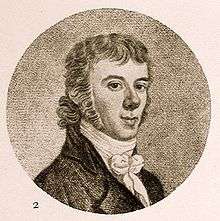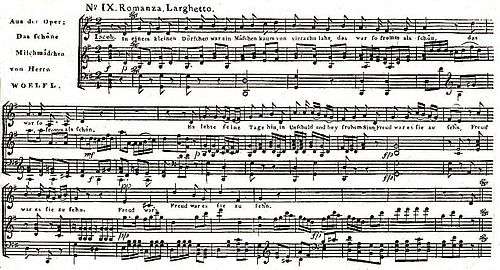Joseph Wölfl

Joseph Johann Baptist Woelfl (German spelling:) Joseph Wölfl (24 December 1773 - 21 May 1812) was an Austrian pianist and composer.
Biography

Woelfl was born at Salzburg, where he studied music under Leopold Mozart and Michael Haydn.
He first appeared in public as a soloist on the violin at the age of seven. Moving to Vienna in 1790 he visited Wolfgang Mozart and may have taken lessons from him. His first opera, Der Höllenberg, appeared there in 1795.
Woelfl was very tall (over 6 feet), and with an enormous finger span (his hand could strike a thirteenth, according to his contemporary Frantisek Tomasek); to his wide grasp of the keyboard he owed a facility of execution which he turned to good account, especially in his extempore performances.
Although he dedicated his 1798 sonatas op. 6 to Beethoven, the two were rivals. Beethoven however bested Woelfl in a piano 'duel' at the house of Count Wetzlar in 1799, after which Woelfl's local popularity waned.[1] After spending the years 1801 -1805 in Paris, Woelfl moved to London, where his first concert performance was on 27 May 1805.
In England, he enjoyed commercial if not critical success. In 1808 he published his Sonata, Op. 41, which, on account of its technical difficulty, he entitled Non Plus Ultra; and, in reply to the challenge, a sonata by Dussek, originally called Le Retour à Paris, was reprinted with the title Plus Ultra, and an ironic dedication to Non Plus Ultra. He also completed for publication an unfinished sonata of George Pinto.
Woelfl died in Great Marylebone Street, London, on 21 May 1812.
Woelfl's works have long disappeared from the concert repertory. However, in 2003 four selected piano sonatas of his (Op. 25 and Op. 33) were recorded by the pianist Jon Nakamatsu (Harmonia Mundi CD # 907324). (An Adda CD in 1988 contained his three opus 28 sonatas, played by Laure Colladant, who also recorded the sonatas opus 6 for Adès in 1993 and the three opus 33 sonatas for the label Mandala in 1995.)
.png)
In 2006, German pianist Yorck Kronenberg recorded Woelfl's piano concertos 1, 5 and 6 in addition to a movement from the piano concerto 4.[2] The piano concertos closely resemble the later piano concertos of Mozart, who had pioneered the genre; they can be distinguished from Mozart's works by the larger range of the piano, which had been extended shortly after Mozart's death.
Piano Concertos
- Piano Concerto No. 1 op. 20 in G major (ca 1802-1803)
- Piano Concerto No. 2 op.26 (published c.1806)
- Piano Concerto No. 3 op.32 in F major
- Piano Concerto No. 4 op. 36 in G major "The Calm" (published c.1808)
- Piano Concerto No. 5 op. 43 in C major "Grand Military Concerto" (1799?)
- Piano Concerto No. 6 op. 49 in D major "The Cuckoo" (published 1809)
Symphonies
- Symphony in G minor op. 40.' Dedicated to Luigi Cherubini.[3][4]
- Symphony in C major op. 41.' Dedicated to Johann Peter Salomon.[3][5]
(Note: these two symphonies are not to be confused with Mozart's works K. 550 and K. 551.)
- IMSLP has an autograph manuscript of a 1807 "Symphony No.3" by Woelfl (in one movement, or one movement of a larger work.)
- A publication ca.1825 was made of 3 "Grand Symphonies" by Wölfl. (The British Library record does not give an opus number.)
- The Moldenhauer archive has (in manuscript, though possibly not autograph) part of what is described as "J. Woelfl's 5th grand sinfonia : for full band".[6]
String Quartets
Operas

- Der Höllenberg (Freihaus-Theater 1795), Libretto by E. Schikaneder
- Das schöne Milchmädchen, oder Der Guckkasten (1797)
- Der Kopf ohne Mann (1798)
- Liebe macht kurzen Prozess, oder Heirat auf gewisse Art (1798)
- Das trojanische Pferd (1799)
- L'Amour romanesque (1804)
- Fernando, ou Les maures (1805)
Other works
- 68 Sonatas for the piano, several sonates for piano and violin, 18 piano trios, and some 4-hands music
- Grand Duo in D minor for Pianoforte and Violoncello op. 31. Dedicated to Madame Hollander
- Clarinet concerto in B♭ major (premiered 1796)[13][14]
- Variations, rondós, German dances...
Influenced
- Charles Neate, one of the original members of the Philharmonic Society.
- Joseph Bottomley, future organist at Sheffield.
Thematic catalogue (Werkverzeichnis) and Biography
- Margit Haider-Dechant: Joseph Woelfl. Verzeichnis seiner Werke. Apollon-Musikoffizin Vienna 2011
- Margit Haider-Dechant: Art. Wölfl, Joseph. In: Die Musik in Geschichte und Gegenwart. Zweite, neubearbeitete Ausgabe, hrsg. von Ludwig Finscher, Personenteil Bd. 17, Kassel u. a., 2008, pp. 1122–1128.
References
- ↑ Denora, Tia (1996). ""The Beethoven-Woelfl piano duel". In Jones, David Wyn. Music in eighteenth-century Austria. Cambridge: Cambridge University Press. pp. 259–282.
- ↑ http://www.arkivmusic.com/classical/album.jsp?album_id=200841
- 1 2 Published around 1808 according to Bayerische Staatsbibliothek.
- ↑ Parts and movement breakdown @ the Moravian Music Foundation - see OCLC 905233658. This work is rather larger in dimensions (320+ bars in each of first movement and finale) than Wölfl's Op. 41.
- ↑ Parts available at the Moravian Music Foundation - see OCLC 905233657. Only somewhat shorter, until the finale, than Mozart's last symphony, though- according to the Moravian Music Foundation, Wölfl's symphony has a 261 measure first movement to 313 for Mozart; 132 measure Andante (101 measures in Mozart); an Allegro con fuoco menuetto & trio of 74 bars (77 bars of Allegretto m&t in Mozart); the finales are 165 bars Allegro assai and 423 bars respectively...
- ↑ Re Wölfl's 5th symphony, see OCLC 122417037. Dated March 1808.
- ↑ see description from Austrian National Library (ÖNB) entry of Op.4 based on Vienna: Kozeluch parts (plate 243)
- ↑ Description of String Quartet Op.5 No.2 from Austrian National Library ; Quartet Op.5 No.1 also from ÖNB; Op.5 No.3 also from ÖNB
- ↑ Austrian National Library description of Book 1, nos.1-3
- ↑ IMSLP has all 6 quartets.
- ↑ OCLC 905231734 - manuscript parts @ Moravian Music Foundation.
- ↑ British Library Holdings.
- ↑ Clarinet concerto first published 2013 by Apollon Musikverlag; see Apollon Musikverlag page, which has an image of the first page of the score (clearly B-flat major). "Die Uraufführung fand am 27. 09. 1796 im kaiserl. königl. Hoftheater in Wien statt."
- ↑ OCLC 927292895
- Opera Glass
- Discogs
